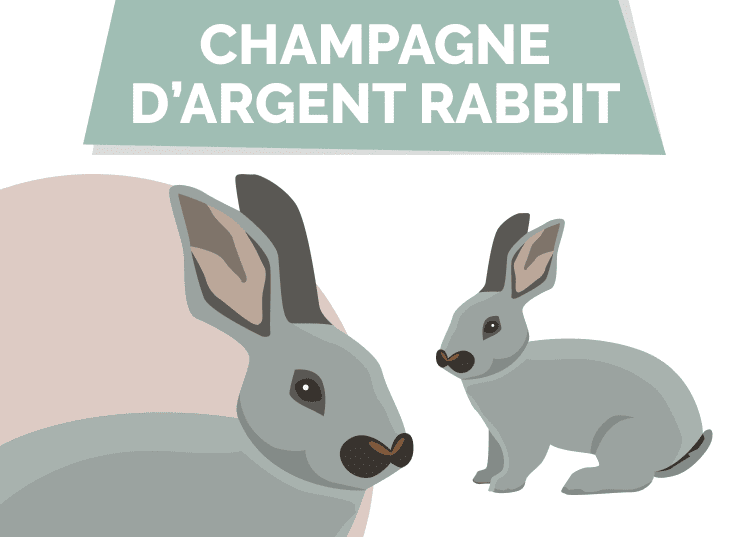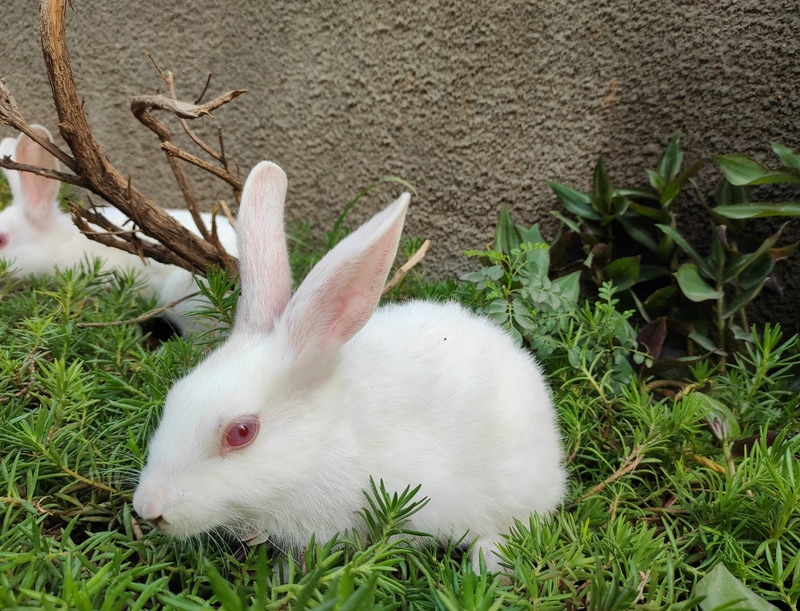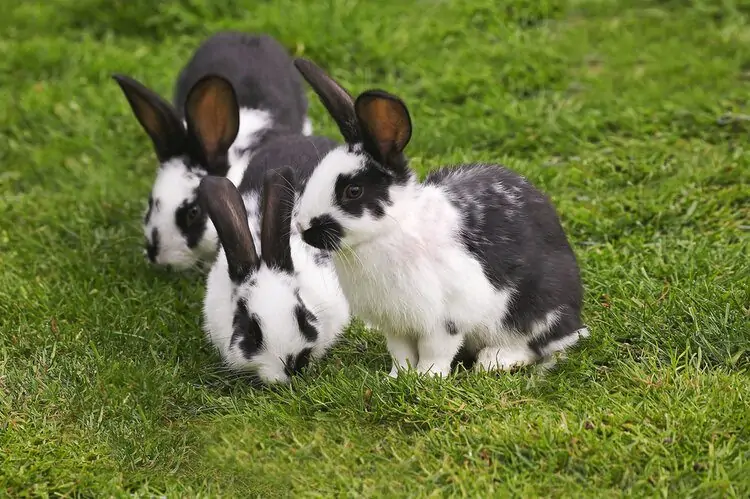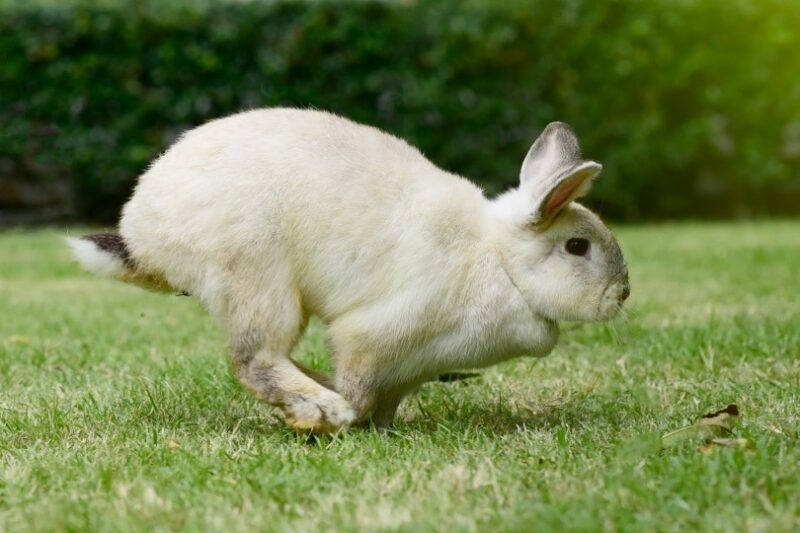Champagne D’Argent Rabbit: Pictures, Care Guide, Lifespan & Traits

Updated on

The Champagne d’Argent Rabbit is a medium breed known for its shiny, silver color. Because it looks like they are wearing a coat of armor, some dub this breed the “silver-plated” rabbit. They were developed in Champagne, France, but are known worldwide.
Early on in the development of the breed, both its fur and its lean flesh were highly valued. It is now bred as a companion pet and is loved because of its attractive appearance and social temperament.
The Champagne d’Argent gets along with other animals, humans, and rabbits, but if you are still deciding if this is the breed for you, we have got you covered. Read on to learn more about this “silver-plated” beauty.
The most unique trait of the Champagne d’Argent is that they change color. The baby rabbit will have a black coat when it is born, and only once it reaches maturity will the silver hue start to appear. When the rabbit is about 8 months old, the silver markings start on the belly and extend to the back and face. As the bunny ages, the hue will continue to lighten.
| Size: | Medium to large |
| Weight: | 9–12 pounds |
| Lifespan: | 6–8 years |
| Similar Breeds: | Argenté Bleu, Argenté Brun, Argenté Noir, Argenté St Hubert |
| Suitable for: | Show rabbits, families with children, first-time owners |
| Temperament: | Friendly, docile, well-mannered, calm, sweet |
The Champagne d’Argent is a French breed of domesticated rabbit. Although its precise history is somewhat disputed, it is one of the oldest recognized breeds. Only Crème and Champagne are recognized as color variations in the USA, whereas Blue, Brun, Crème, Noir, and Champagne are the five color variations recognized in the United Kingdom.
However, regardless of the color variation you choose, if you want a friendly pet that gets along with everyone in the family, then the Champagne d’Argent is ideal.
Champagne d’Argent Rabbit Characteristics
How Much Do These Rabbits Cost?
The Champagne d’Argent’s price will vary depending on whether it is purebred, showbred, or bred for meat. It will also depend on the breeder and where you get it from. It is a popular breed, and it shouldn’t be too difficult to find and will likely be cheaper than other rabbits that aren’t as popular. You may even find one of the rabbits in a local shelter.
The price for a Champagne d’Argent from a breeder can range between $45–$75 depending on pedigree, conformity, and proven breeding ability. Some can cost up to $100, depending on quality.
There are additional expenses related to caring for a rabbit, regardless of whether you buy or adopt. A hutch and other supplies should cost between $200 and $300, and you’ll spend approximately $20 monthly for food and maintenance.
Temperament & Intelligence of the Champagne d’Argent Rabbit
Many people liken these French silver rabbits to well-behaved cats because they enjoy spending time with you when they want to, but they can also be independent and prefer to be by themselves. They have a laid-back, docile nature and are usually calm and sweet rabbits who can be curious sometimes.
They are friendly and may not be overly affectionate, but that doesn’t mean they won’t occasionally appreciate a cuddle. They are also an intelligent breed. While not as intelligent as cats and dogs, they can be trained to use their litter box and do a few tricks.
Do These Rabbits Make Good Pets?👪
Champagne d’Argent Rabbits make great family pets. If they are handled properly, they are great for families with children. Because of their docile nature and low-maintenance needs, they are also great for first-time owners.
From an early age, the Champagne d’Argent must be socialized with their family. Once socialized, they will like being close to you. You should always respect your rabbit’s personal space, especially if they are new to your home. Spend time with them daily, remove them from the hutch, and give them time to become adjusted to the sounds and your presence so that they do not grow up to be uneasy and jittery.
Does This Rabbit Get Along With Other Pets?
In general, rabbits are friendly creatures. As long as they are socialized early, Champagne d’Argent rabbits get along well with other rabbits. They can live in groups with other rabbits of the same breed and sex, but males and females should not be kept together unless you are ready for the frequent arrival of a litter.
They can also get along with dogs and cats if they are socialized and brought up together. However, don’t leave them together unattended since your cat or dog’s prey drive could kick in.
Things to Know When Owning a Champagne D’Argent Rabbit:
Food & Diet Requirements 🥕
Like other rabbits, the Champagne d’Argent requires a diet that is 70% hay. Hay provides the fiber your rabbit needs and the grinding motion to manage the rabbit’s teeth, which keep growing throughout its lifetime.
Pellets may also be a part of your rabbit’s diet but should comprise less than 5%. Even though pellets are made of hay, they contain vitamins and minerals your rabbit won’t find in its hay or vegetables. However, they can cause weight gain if eaten too frequently.
The remaining 15% of a rabbit’s diet should be made up of leafy green vegetables, though you can occasionally give it treats such as carrot tops, apples, blueberries, cabbage, and broccoli.
They should also have an available supply of clean, fresh water.
Habitat & Hutch Requirements 🏠
Your Champagne d’Argent can live indoors or outdoors, whichever suits you best. Some owners prefer the outdoors as there is more space to run around, but you must ensure that your rabbit is protected from the elements.
A bunny requires twice as much space as its size to stretch out. This means that a hutch for a Champagne d’Argent should be 6 feet long. It needs to be 2 feet wide and about 2 feet tall to provide ample space to move comfortably. If housed outside, your rabbit needs a separate sleeping room, and at least 75% of the hutch must be completely covered to protect it from the elements.
Depending on your available space, a run can be 6’ x 4’ or 12’ x 2’ x 6’ and should provide 24 square feet of room. Bigger is always better. Your rabbit will benefit from getting its daily exercise if you can combine the run with its living space.
It is necessary to cover the hutch with comfortable bedding. The most popular bedding materials are hay, straw, or sawdust, and they should have a depth of around 5 inches.
Exercise & Sleeping Needs 🐇
Rabbits in the wild can run about 3 miles each day, so providing your rabbit with enough daily exercise is crucial. Whether this is spent outside of their hutch in the backyard, running through tubes, or simply roaming the house, they need daily exercise to stay healthy.
The Champagne d’Argent rabbit is not one of the most active rabbit breeds. Therefore, it may need some encouragement. Although they will enjoy the occasional hopping around, toys and treats can encourage them to be more active. Given their social nature and desire to spend time with you, they may be more likely to participate in their exercise if you get involved.
Rabbits are most active in the early morning, at night, and sunset. They are quiet throughout the day and sleep for approximately 6–8 hours.
Training 🥎
Although training a rabbit is more difficult than training a dog or cat, it is still possible! Your rabbit can be trained to use a litter box, and you can train it to respond when its name is called.
Rabbits can be potty trained with patience and rewards, but it takes a lot longer than with other pets. To prevent them from being encouraged to eliminate in a corner, try utilizing multiple litter boxes throughout the house rather than just one. Adding a small handful of hay to one side of the box can encourage the bunny to hop in.
Training your rabbit to target or set its nose to a specific location is the first stage in teaching it tricks. This can be used to perform larger tricks like command jumps, circles, and agility courses. Teach it to target or focus its nose on a particular point, such as a short stick with a tiny ball on one end.
Give the rabbit a treat when they touch the ball with their nose after you show it to them. Once the rabbit begins pursuing the ball, you can use it to direct it in the direction you want. Slowly spin it over the rabbit’s head to make it walk in circles. You can also teach your rabbit to jump by raising the ball in the air and rewarding it with a treat each time it jumps up. Eventually, you will be able to eliminate the stick from the equation as your rabbit begins to understand that the behavior it engages in is what earns it the treat.
Grooming ✂️
The Champagne d’ Argent sheds, so you must brush it at least once a week. It would be best to brush your rabbit every day throughout the shedding season, which you will know has arrived when you notice you are covered in hair after holding your rabbit. If your Champagne d’Argent gets dirty, avoid bathing it and wipe it down with a moist cloth. You should also trim their nails when needed.
Lifespan and Health Conditions 🏥
Fortunately, no breed-specific health issues affect the Champagne d’ Argent. However, they are vulnerable to many of the same problems as all breeds.
Serious Conditions:
When flies lay their eggs on dirty patches of fur, the eggs hatch, and the larvae start eating the rabbit from the inside out, which can be fatal within 24 hours. This horrible condition is known as flystrike. Make sure your rabbit’s rear is always clean, especially as they age.
Minor Conditions:
Malocclusion refers to the misalignment of the upper and lower teeth, which prevents your rabbit’s teeth from becoming worn down by normal eating. It’s important to have regular dental exams and ensure your rabbit eats plenty of hay.
Ear mites are a common parasite of pet rabbits. You may notice your rabbit frequently shaking its head if it is infected.
They can develop back problems like other rabbits if they are handled improperly or unintentionally dropped.
Champagne d’Argent rabbits live for roughly 6 to 8 years. You can guarantee you catch any health issues early on by scheduling routine checks with your veterinarian. Make sure the breeder you are purchasing from is reputable as well to ensure they live long and healthy lives.
Male vs Female
Generally speaking, male rabbits are friendlier and more relaxed. A male rabbit is more suitable for you if you’re looking for one who is more sociable or attentive. For beginners caring for rabbits, males are typically easier. They are known for having calmer personalities and less destructive tendencies. They also tend to be less territorial.
Typically, female rabbits are more assertive than male rabbits. Additionally, female rabbits are more aloof toward humans. They might be less interested in spending time with you and more inclined to pursue their interests. However, a female is likely to be very loving and affectionate once she decides she loves you and accepts you as a family member. Female rabbits are more likely to lick you or your clothing at this point to express their appreciation.
It’s also important to note that these are merely generalizations and that not all rabbits exhibit these traits. If you have the option, it is much better to visit the animal shelter or breeder, where you can meet the rabbits and get to know them better.
The 3 Little-Known Facts About Champagne D’Argent Rabbits
1. They Are Born Black
They Are Born Black, and Their Coats Start to Take on a Silver Color as They Grow.
2. Silvering Gene
They Have the Same Silvering Gene as Lipizzaner Horses.
3. One of the Oldest
The Champagne d’Argent Is One of the Oldest French Show Breeds and Recognized Rabbits.
Final Thoughts
The Champagne d’Argent is a domesticated French breed that’s prized for its gorgeous silver coat. While they were originally bred for their pelts and meat, they make excellent show rabbits and beloved pets for almost any type of family. They have a docile, laid-back nature and are low-maintenance rabbits, making them ideal pets for first-time rabbit owners.
They can be housed indoors or outdoors, raised with other pets, and easily trained to use a litter box, respond to their name, and perform a few simple tricks. They will need enough daily exercise, early socialization, and routine veterinary check-ups to ensure they live a long and healthy life. This breed will happily sit on your lap and nibble on tasty treats from your hand while enjoying its time with you!










